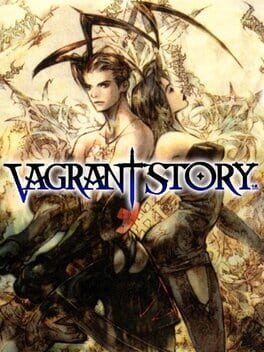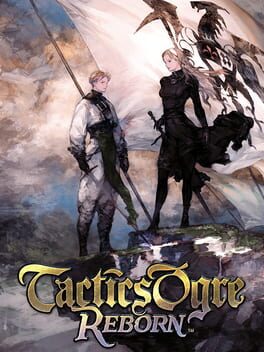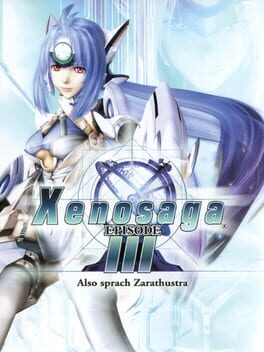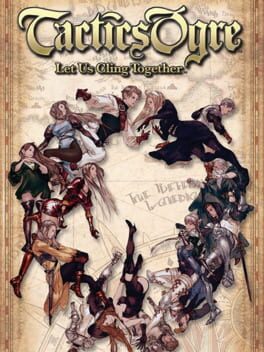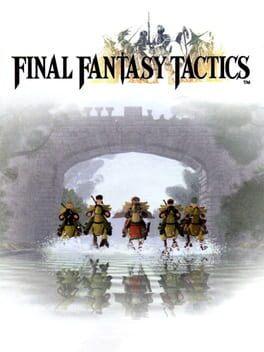ChaoticBrave
19 reviews liked by ChaoticBrave
Persona 3 FES
2007
Vagrant Story
2000
A true work of art that is full of passion, ambition, professionalism, and creativity
Vagrant Story is the miracle of Yasumi Matsuno, his final game and magnum opus. While not without its flaws, Vagrant Story is a true testament to what video games could be when designed with mature audiences in mind. Its storytelling techniques are the absolute best I've ever encountered in the medium. It's beautifully written in an artistic,literary language that was unseen in videogames at the time,intertwined with masterful subtext, never babysitting the audience with meaningless plot expositions. It is a tale full of intricate characters; every piece of dialogue is quotable with an exquisite use of Shakespearean English,thanks to the brilliant translation by Alexender O. Smith,but also masterfully packed and well balanced with just the right amount of characterization and plot significance. Implicit storytelling places it farther than it's counterparts and closer to modernist novels,with how the player is expected to piece together the plot points they're given rather than explaining every single thing. This type of implicated storytelling still hasn't been fully replicated in the videogame landscape,a fact that is enough to represent Matsuno as a gifted writer and a unique auteur in the industry.
It is impossible to talk about Vagrant Story without mentioning it's technical aspects.Matsuno and his team pushes the PS1 hardware to it's absolute limits,without bogging down the experience with low framerate and slowdown issues.Diving into the development history reveals how team struggled to make the game run on a stable framerate with such detailed visuals,and spend 3 whole years to optimize the game with unconventinal techniques for the time, without limiting it's vision.And the result is a game that looks incredible for the hardware, both from a technical and stylistic standpoint.Immense attention to detail in every room,lighting effects,smooth animations,detailed facial expressions and striking designs of every character,monster and location gives the game a unique art direction that uses it's hardware limitations to it's advantage,and still holds up tremendously well.
With how Vagrant Story focuses on it's technical aspects and storytelling,it is easy to assume that gameplay was a second thought of the team,most of the modern games that are considered "cutting edge" doesn't usually offers deep mechanics and solely focuses on their high quality presentation.This is absolutely not true for Vagrant Story.With a mixture of traditional dungeon crawling and action RPG systems,combining menu selections with real-time combat and free movement, it is easy to classify it as an action RPG, however,the menu navigation part is more involved than most turn-based RPGs. With combat requiring the player to take advantage of several weaknesses of the enemies,whether that be the weapon type,body part,elemantal or class weaknesses, every combat encounter requires the player to analyze the enemies extensively before engaging them to decide which tool in their in their varied arsenal they should use, and more importantly, how should they use. Once you adjust your equipment accordingly, engaging the enemy has a whole other set of factors to consider when designing your strategy. The most prominent of these are chain attacks, which are timed button presses you need to do in order to deal damage, not unlike games such as Super Mario RPG. However, like everything about the combat system,these attacks can be deeply customized to have all kinds of different effects other than simply inflicting damage. These can be draining the opponent's MP or HP,inflicting status ailments such as silence or poison, renewing your weapon's damage point by small amounts, etc. These abilities mean that every encounter is like a puzzle with multiple solutions you can choose from. However, the player can't just rely on their reflexes to beat even the most powerful bosses, because the more you use these chain attacks, the more your "risk" bar rises. Risk bar is similar to a stamina bar, your limititation to attack endlessly; however,it is arguably a far more creative use of this concept. As your risk bar increases, the more you get hit and the lower your hit rate gets. This adds another important factor, in a game already dominated by numerous complicated systems, you have to figure out the most optimal way to play in order to conquer the game's challenges. There are a lot more to talk about,such as a crafting system,your weapon's damage point and phantom point,different types of enemies,box puzzles and actual dungeon crawling, etc. But for now, I'll keep it there.
The amount of complexity and density of the systems can be overwhelming for many, but for those who prioritize micromanagement, customization, and experimentation in RPG gameplay systems,it is very rewarding and satisfying to master the intricate gameplay,with subsystems upon subsystems to learn. Every single system complements each other to create an incredibly deep gameplay loop with tons of things to consider. It is easy to say, both in terms of story and gameplay, that Vagrant Story is not the kind of game you can fully comprehend and appreciate in a single playthrough. It is a short yet polished experience, to the point where it shines as one of the brightest gems in videogame history. It is a technical marvel,a work of art with experiential storytelling and direction techniques; a passion project; it is dramatic and theatrical,but not awkward or unnatural; it is mechanically rich and unique; sometimes cumbersome,yet always engaging. It takes a lot from a lot of different genres,while not truly belonging to any of them,and creates its own unique and memorable identity. It is a kind of masterpiece we'll never see anything similar to it ever again
Vagrant Story is the miracle of Yasumi Matsuno, his final game and magnum opus. While not without its flaws, Vagrant Story is a true testament to what video games could be when designed with mature audiences in mind. Its storytelling techniques are the absolute best I've ever encountered in the medium. It's beautifully written in an artistic,literary language that was unseen in videogames at the time,intertwined with masterful subtext, never babysitting the audience with meaningless plot expositions. It is a tale full of intricate characters; every piece of dialogue is quotable with an exquisite use of Shakespearean English,thanks to the brilliant translation by Alexender O. Smith,but also masterfully packed and well balanced with just the right amount of characterization and plot significance. Implicit storytelling places it farther than it's counterparts and closer to modernist novels,with how the player is expected to piece together the plot points they're given rather than explaining every single thing. This type of implicated storytelling still hasn't been fully replicated in the videogame landscape,a fact that is enough to represent Matsuno as a gifted writer and a unique auteur in the industry.
It is impossible to talk about Vagrant Story without mentioning it's technical aspects.Matsuno and his team pushes the PS1 hardware to it's absolute limits,without bogging down the experience with low framerate and slowdown issues.Diving into the development history reveals how team struggled to make the game run on a stable framerate with such detailed visuals,and spend 3 whole years to optimize the game with unconventinal techniques for the time, without limiting it's vision.And the result is a game that looks incredible for the hardware, both from a technical and stylistic standpoint.Immense attention to detail in every room,lighting effects,smooth animations,detailed facial expressions and striking designs of every character,monster and location gives the game a unique art direction that uses it's hardware limitations to it's advantage,and still holds up tremendously well.
With how Vagrant Story focuses on it's technical aspects and storytelling,it is easy to assume that gameplay was a second thought of the team,most of the modern games that are considered "cutting edge" doesn't usually offers deep mechanics and solely focuses on their high quality presentation.This is absolutely not true for Vagrant Story.With a mixture of traditional dungeon crawling and action RPG systems,combining menu selections with real-time combat and free movement, it is easy to classify it as an action RPG, however,the menu navigation part is more involved than most turn-based RPGs. With combat requiring the player to take advantage of several weaknesses of the enemies,whether that be the weapon type,body part,elemantal or class weaknesses, every combat encounter requires the player to analyze the enemies extensively before engaging them to decide which tool in their in their varied arsenal they should use, and more importantly, how should they use. Once you adjust your equipment accordingly, engaging the enemy has a whole other set of factors to consider when designing your strategy. The most prominent of these are chain attacks, which are timed button presses you need to do in order to deal damage, not unlike games such as Super Mario RPG. However, like everything about the combat system,these attacks can be deeply customized to have all kinds of different effects other than simply inflicting damage. These can be draining the opponent's MP or HP,inflicting status ailments such as silence or poison, renewing your weapon's damage point by small amounts, etc. These abilities mean that every encounter is like a puzzle with multiple solutions you can choose from. However, the player can't just rely on their reflexes to beat even the most powerful bosses, because the more you use these chain attacks, the more your "risk" bar rises. Risk bar is similar to a stamina bar, your limititation to attack endlessly; however,it is arguably a far more creative use of this concept. As your risk bar increases, the more you get hit and the lower your hit rate gets. This adds another important factor, in a game already dominated by numerous complicated systems, you have to figure out the most optimal way to play in order to conquer the game's challenges. There are a lot more to talk about,such as a crafting system,your weapon's damage point and phantom point,different types of enemies,box puzzles and actual dungeon crawling, etc. But for now, I'll keep it there.
The amount of complexity and density of the systems can be overwhelming for many, but for those who prioritize micromanagement, customization, and experimentation in RPG gameplay systems,it is very rewarding and satisfying to master the intricate gameplay,with subsystems upon subsystems to learn. Every single system complements each other to create an incredibly deep gameplay loop with tons of things to consider. It is easy to say, both in terms of story and gameplay, that Vagrant Story is not the kind of game you can fully comprehend and appreciate in a single playthrough. It is a short yet polished experience, to the point where it shines as one of the brightest gems in videogame history. It is a technical marvel,a work of art with experiential storytelling and direction techniques; a passion project; it is dramatic and theatrical,but not awkward or unnatural; it is mechanically rich and unique; sometimes cumbersome,yet always engaging. It takes a lot from a lot of different genres,while not truly belonging to any of them,and creates its own unique and memorable identity. It is a kind of masterpiece we'll never see anything similar to it ever again
Vagrant Story
2000
Vagrant Story
2000
Squaresoft and Yasumi Matsuno's second collaboration spawned the painstakingly crafted Vagrant Story, a hyper-intricate and hyper-mystifying gem, perhaps the culmination of the former's acrobatic presentation and the latter's disquieting writing. Alongside the visuals, what immediately stands out are the main cutscenes: A minimal and reckless form of storytelling, packed with refined - almost cryptic language and portrait-worthy shots in which characters enter, ponder and exit with (seemingly) little to no regard for identity nor coherence, only to slowly decode a tragic plot and cast as it proceeds. The best moments - in particular, emit an immersive yet disorienting atmosphere that reminds one of the more abstract, ghostly experiences of Xenogears' second disc, while others are boss fight intros rendered in creative and dramatic ways. Its structure, both narratively and functionally, had little in common with JRPGs; largely indifferent to the hero's journey and to the village-to-dungeon format (basically a gradually-unraveling dungeon-crawler that disposed of the hub, shops, friendly NPCs, currency, etc.), which becomes an attraction in itself.
Equally original is the gameplay, ostensibly a mix of action-adventure, platforming and ARPG whose combat combines free movement with menu-selection pauses (reminiscent of Parasite Eve minus the ATB gauge) and damage-able limbs a la Front Mission. But in reality, it's the systems that tower over the rest; dense and overwhelming in a vein similar to Ogre Battle (another Matsuno-led project). The most striking aspect is probably how one's equipment factors into hit/damage calculations, utilizing not one but three sets of resistances + weaknesses (affinity, class and type, i.e. elements, species and weapon blades, respectively), and partly governed by mutating stat levels (e.g. Fire, Undead, Piercing) tied to both gear and enemies. At the same time, mechanics such as Break Arts (weapon-exclusive supers unlocked via use-based mastery), Chain Abilities (that evolves SMRPG via quasi-unlimited, unlockable offensive/defensive follow-ups), and especially the aptly-named RISK (a secondary meter that trades accuracy and defense for crit-rate and healing power as chains accumulate) add even more rules and layers to this peculiar brand of strategic-action. This game's most trivial system would be a main feature on other RPGs.
Other - but no less vital mechanics complement the more distinguished ones, ranging from crafting, weapon mods, equipment tiers, durability, proficiency, etc. Altogether, these ideas form a convoluted web of interactions that turns each encounter into a flexible customization challenge, where bosses can either last for 20 minutes or fall to a single chain combo. Not even its many drawbacks (the overdemanding and sometimes hopeless early-game situations, the constant menu setup and the input-bloat) could spoil this multifaceted type-matching approach. By the end, the player has gathered and honed a virtual toolbox of equipment, magic and augments to construct specialized builds for any battle scenario.
A veritable alien JRPG encyclopedia, elegant and puzzling, theatrical but never awkward nor melodramatic, complicated yet intriguing, Vagrant Story absorbs and weaves together concepts from all sorts of past games without belonging to any of them.
Equally original is the gameplay, ostensibly a mix of action-adventure, platforming and ARPG whose combat combines free movement with menu-selection pauses (reminiscent of Parasite Eve minus the ATB gauge) and damage-able limbs a la Front Mission. But in reality, it's the systems that tower over the rest; dense and overwhelming in a vein similar to Ogre Battle (another Matsuno-led project). The most striking aspect is probably how one's equipment factors into hit/damage calculations, utilizing not one but three sets of resistances + weaknesses (affinity, class and type, i.e. elements, species and weapon blades, respectively), and partly governed by mutating stat levels (e.g. Fire, Undead, Piercing) tied to both gear and enemies. At the same time, mechanics such as Break Arts (weapon-exclusive supers unlocked via use-based mastery), Chain Abilities (that evolves SMRPG via quasi-unlimited, unlockable offensive/defensive follow-ups), and especially the aptly-named RISK (a secondary meter that trades accuracy and defense for crit-rate and healing power as chains accumulate) add even more rules and layers to this peculiar brand of strategic-action. This game's most trivial system would be a main feature on other RPGs.
Other - but no less vital mechanics complement the more distinguished ones, ranging from crafting, weapon mods, equipment tiers, durability, proficiency, etc. Altogether, these ideas form a convoluted web of interactions that turns each encounter into a flexible customization challenge, where bosses can either last for 20 minutes or fall to a single chain combo. Not even its many drawbacks (the overdemanding and sometimes hopeless early-game situations, the constant menu setup and the input-bloat) could spoil this multifaceted type-matching approach. By the end, the player has gathered and honed a virtual toolbox of equipment, magic and augments to construct specialized builds for any battle scenario.
A veritable alien JRPG encyclopedia, elegant and puzzling, theatrical but never awkward nor melodramatic, complicated yet intriguing, Vagrant Story absorbs and weaves together concepts from all sorts of past games without belonging to any of them.
Tactics Ogre: Reborn
2022
Xenosaga: Episode III returned to the lengthy format of Episode I and even Xenogears, with moments - particularly in the final few chapters, that rival and sometimes surpass that degree of emotional power and horror. While the graphics and dungeon creativity are certainly beefed up, the other non-story related elements are lacking. Combat regressed to a simpler, traditional burst damage format with a heavier importance on elemental damage, while many other gameplay features are simple, minor adjustments that don't improve much overall. Not a step forward or back but a derivative turn. At least the mecha battles are (finally) interesting. The occasional embarrassing sci-fi action trope or tiresome JRPG villain hinders some of the experience, but the majestic story events and impactful character moments overcompensate in quality. Monolith Soft was at their best writing these remaining subplots, pacing and closing their trilogy gloriously.
>enemy commander shows up
>"he he ho ho i'm gonna kill you >:)c"
>casts super hell shadow pain missile at him
>enemy commander, dying, opening up a heart shaped locket: "now I, as a single father who is very well loved by their local community, won't be able to pay for my blind child's cancer medicine :("
>enemy commander yelps, falls over face first and drops a potato sack
>1.5 seconds of silence
>"CONGRATULATIONS" in bold and golden words pops up on screen
>the entire Cincinnati Orchestra puts their whole pussy into playing a fanfare tune
>a whole ass audience worth of people scream in applaud at the loot you stole off his corpse
good game
>"he he ho ho i'm gonna kill you >:)c"
>casts super hell shadow pain missile at him
>enemy commander, dying, opening up a heart shaped locket: "now I, as a single father who is very well loved by their local community, won't be able to pay for my blind child's cancer medicine :("
>enemy commander yelps, falls over face first and drops a potato sack
>1.5 seconds of silence
>"CONGRATULATIONS" in bold and golden words pops up on screen
>the entire Cincinnati Orchestra puts their whole pussy into playing a fanfare tune
>a whole ass audience worth of people scream in applaud at the loot you stole off his corpse
good game

